History student, Honours year. Colonial & carceral histories of sexuality and gender in 18th-19th century Australia. Queer archive volunteer. 🏳️🌈+🏳️⚧️. Not American.
Don't wanna be here? Send us removal request.
Link
This— there were specific, political reasons that (e.g.) ‘lesbian’ became a specific, separate designation from the broader ‘gay’ umbrella. However, the shattering of ‘gay’ into ‘LGBT’ is part and parcel of the depoliticisation of gay liberation as a distinctly leftist, progressive movement. I don’t think you can meaningfully separate it from the hierarchical ordering of the community, or the rise to dominance of respectability/acceptability politics and the ‘leadership’ of comparatively conservative gay and lesbian folks (in the US/UK at least, the Australian context is a little different).
Anyway, for added context, you might be interested in this quote from an Australian gay newsletter that discusses bisexuality from the negative perspective. I think this confirms Robinson’s points, but from the opposite perspective. Also worth noting here is the use of homosexual and homosexuality, which is also more expansive in meaning: you can see that while it’s referring to an identity, this identity is based on political practice within a liberatory goal, rather than the way that t—f aligned men use it now.


Obviously this doesn’t mean that everyone thought that way, but I would be willing to bet— not having researched it myself— that the Venn diagram is a circle when it comes to who was a masculinist homophile and who supported exclusionary uses of homosexual/gay. Australia never had prominent homophile groups, and I’d suggest that helps explain precisely why we’ve generally been more resistant to virulent forms of exclusionism embedding themselves within community practices. Homophile conservatism, however, gained significantly greater prominence and ground in the US in particular and, to the best of my knowledge, has also featured fairly strongly in Europe (the UK included) as a specific line of political thought that latched itself onto gay liberation.
(Note: I’d normally credit the author but this was an editorial and— unfortunately— I didn’t note down the publication. I can attempt to dig it out of the archival boxes in the coming week, however will note that in terms of time period it was written circa the late 70s-80s).
“"Glad Not To Be Gay" shouted an Independent headline a few weeks ago - illustrated with a huge picture of my family. The article wasn’t even about me. I don’t want to keep harping on about it, but ten years of this kind of media bollocks is really starting to wear a bit thin. Everyone repeat after me: no-one ever stopped being homosexual by sleeping with a member of the opposite sex. God knows enough sad, deluded people have tried. I love my partner and kids more than anything in the world, but I’m still gay, glad and queer as a bottle of Crisps. Come on guys, you’ve been there. It’s not unknown for a gay man to mistake a boyish woman for the guy of his dreams across a crowded room. So what do you do if the woman then grins and throws you a cruisy look ? Sure, you can always look away, muttering “I don’t do bi”. But since we gay men are notoriously fun-loving sexual adventurers who’ll try almost anything, another possibility is to grin back and see what happens. If that makes me (or you) bisexual, well, worse things have happened at sea. What it doesn’t make you (or me) is “Glad Not To Be Gay”. “Gay activist turns straight” is such an irresistible headline, though, it gets written again and again - without reference to any more complex human truths that may underlie the story. Even ‘Don’t Panic’ make a T-shirt with the slogan “The Artist Formerly Known As Gay”. OK, bemoaning the old, lost meaning of “gay” is the usual preserve of Telegraph and Spectator columnists, but 25 years ago the “gay” in Gay Liberation Front covered pretty much any deviation from the hetero norm: homo, lesbian, butch, fem, leather, drag, vanilla, transgender, whatever. “Gay” was an inclusive, liberating concept that welcomed bisexuals at its marches and parties alongside everybody else - and I for one mourn its passing.”
This is a really interesting article about the shifting meaning of “gay” by Tom Robinson, a bisexual man who hass been a musical activist since the 70s.
He actually used to not want to identify as bisexual because he had a strong preference for men and the general attitude was that “bisexual” was a cop-out.
18 notes
·
View notes
Text
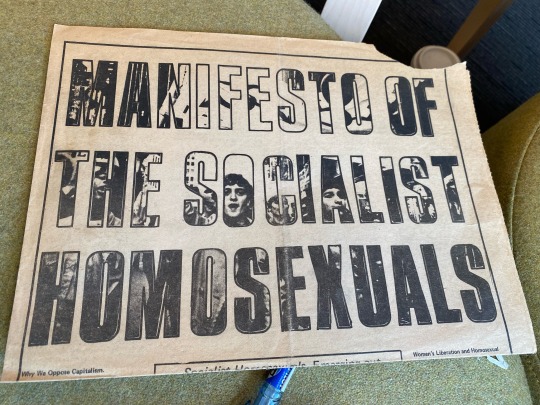

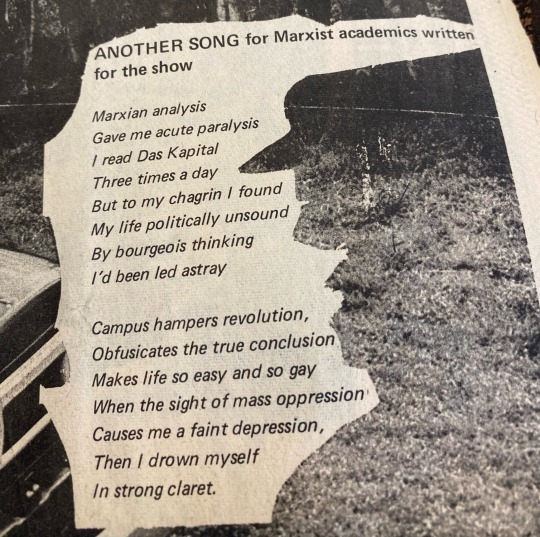

A collection of four gay liberation papers, demonstrating the close ties between left-wing organising and the Australian gay lib movement. The top two come from the 1976 Manifesto of the Socialist Homosexuals, the bottom two are from a queer anarchist paper and satire Marxist groups by painting them as bourgeois intellectuals who would rather talk politics than engage in praxis.
(Photos my own, taken at the Australian Queer Archives. You can find a substantial collection of gay lib material on the site Reason in Revolt).
#history#historyblr#queer history#australian history#gay history#lgbtq history#political history#gay liberation#20th century
87 notes
·
View notes
Text
This quote, from John D’Emilio’s 1989 essay Not A Simple Matter: Gay History and Gay Historians, highlights exactly why I hate the vapid memes about historians and historical erasure:

This is what the founders of gay history, as an academic discipline, were facing at the time: both the genuine barriers within academia and an internalised sense that their work wasn’t as valuable, academic, relevant etc as that produced in other specialisations within history. Queer elders in academia— many of whom lacked formal training, and were community organisers as well— laid the groundwork for those of us continuing that struggle now.
Ignoring the work of actual lgbtq+ historians, past and present, colludes in the erasure and flattening of our history rather than its expansion.
100 notes
·
View notes
Text
Update:
In sad news, Georgina Beyer— world’s first, openly transgender MP— passed away at age 65. She had worked extensively on the campaigns for civil unions and marriage equality, as well as for the rights of sex workers. A Māori woman, she had most recently stood for the Mana Party in 2014.

Note: Article contains language for trans people and sex workers that is now generally considered outdated or inappropriate- terminology in question was in common usage at the time (1999) and is not used maliciously. However, as I transcribe all articles as written, please consider your needs before continuing.
Archive source link.
Image: A woman with dark hair that appears to be tied back, wearing glasses and looking into the camera. She is smiling slightly and wears a business jacket, over which is draped a chain of office.
Text: Transsexual History- New Zealand’s Georgina Beyer is the world’s first known transsexual member of parliament. Rex Wockner’s interview inside. Article appears in Outlines newsletter, dated 1 December, 1999.

Transcription of article below. Wiki article on Georgina Beyer here.
Keep reading
#trans history#lgbt+ history#new zealand history#history#outdated language in text#sex worker history#queer history#tw: death#20th century
19 notes
·
View notes
Text
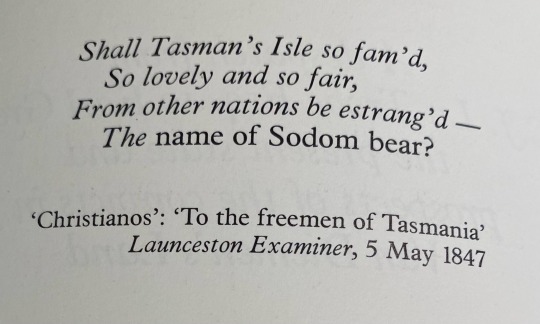
The anti-transportation movement used contemporary fears of social contagion to advocate against the transportation of convicts to the colonies (in this poem, the colony of Van Diemen's Land-- lutrawita in Palawa kani, or Tasmania in English). The prevalence, and relative acceptance, of sodomy within the penal system was believed to be a 'taint' that could spread to the population of free colonists-- particularly amongst the morally vulnerable. This poem is especially political-- the use of Tasmania/Tasman's Isle is a deliberate attempt to cut ties with the penal history of the name Van Diemen's Land.
#homophobia#political homophobia#nineteenth century#australian history#queer history#lgbt+ history#gay history#convicts#convict history
1 note
·
View note
Text
People on this website will really mock anti-vaxxers and flat earthers for ignoring scientists and getting their alternative facts from facebook, and then turn around and insist they know more history than historians and more archaeology than archaeologists because they read an unsourced tumblr post once
93K notes
·
View notes
Text
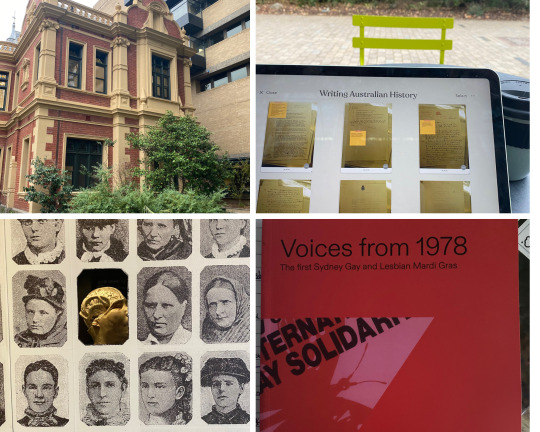
Clockwise: Facade of the 1888 building, annotated readings for The Writing of Australian History, cover of Voices from 1978: The first Sydney Gay and Lesbian Mardi Gras, and a photo of the phrenology art installation.
*
First day back on campus today, for my initial meeting with my Honours thesis supervisor. We talked 19th century sodomy trials and their media coverage in 19th century colonial Victoria, the importance of class and colonialism to histories of sexuality and gender, theories of social contagion and their spread via the press.
Afterwards went for phở, then home to find that my copy of Voices from 1978 had arrived-- a slim history booklet written by the 78ers.
*
Readings:
For fun: Bad Gays by Huw Lemmey and Ben Miller Thesis: The convict probation system, Van Diemen's Land, 1839-1854, with notes by Ian Brand Class: Letters to C. Harley Grattan The Study of History: A Synoptic View, R.M. Crawford History as a Social System, G.M. Dening
1 note
·
View note
Note
I hope I’m not hijacking your thread, but I’d just build on your point to emphasise the importance of location and class to the survival of euphemism and slang. If anon’s book is set in England, the terminology might be plausible, but not necessarily elsewhere. For instance, most of my research has centred around the 1830s-1860s in colonial Victoria (present-day Australia), and while there’s certainly no lack of same-sex desire in our history— a lot of it significantly more visible than one might think— the way this played out, the absence of large cities with organised subcultures etc, the significance of penal transportation, the significant demographic predominance of men in early colonisation, all shaped how such desires were discussed or referred to. “Sod”, for instance, was around in the 1830s as a shortening of “sodomite”, but I’ve never seen anyone refer to mollies or madge culls, as the molly subculture never took root here.
It’s been a while since I’ve read it, but if anon is looking to research the English context, Charles Upchurch’s book Before Wilde: Sex Between Men in Britain’s Age of Reform might help.
Do you any idea when those euphemism would have started being used? I'm writing a book set before the 1850s and finding words for homosexuals in that period is being hell of earth, homosexual itself wasn't coined yet
That particular book (The Classical Dictionary of the Vulgar Tongue, Francis Grose) was written in 1785 and the first edition was by far the least censored. Later editions by the early 19th century sadly removed a lot of the sodomy and f-bombs so they're hard to track. Off the top of my head I'm not sure of other slang dictionaries of that period beyond repeats of Vulgar Tongue, so the question really would be if you think the phrase may have fallen out of fashion by the time your book is set. I get the sense that slang hung around a lot longer then than it does now, though, so you're probably safe. The book was published on and off well into the 1820s.
27 notes
·
View notes
Text
Tonight marks the 45th annual Sydney Gay and Lesbian Mardi Gras parade, one of the seminal moments in Australian queer history. Unfortunately— and in part because of the dominance of (US) American pride discourses, in part because of the transition of the parade from protest to celebration— there’s a general tendency to merely view Mardi Gras as ‘our Stonewall’ without understanding the broader context of Australian histories of sexuality and gender, or recognising the significant differences between Stonewall and Mardi Gras.
This year, I’m marking Mardi Gras by posting three excellent, accessible, and historically informed pieces on what happened on 24 June, 1978 & a piece about life for lgbtq+ elders, some of whom discuss the climate of the 70s and 80s:
ABC’s investigative, multimedia report on the 1st Mardi Gras— featuring interviews with the 78ers.
Sydney’s Mardi Gras: 40 Years of Pride and Protest— in pictures— Text by Nick Henderson, of the Australian Queer Archives.
The joy is waking up and liking who you are— Interviews with 6 lgbt+ elders, on their experiences growing up and growing to love who they are now.
It’s also worth noting that the ABC is airing a series on Australian queer history— Queerstralia— from Tuesday next week. Again, the Australian Queer Archives were one of the groups deeply involved in this, and I’m confident that it will be a genuine contribution to the public history of queer Australia.
Happy World Pride, and Happy Mardi Gras!
#history#historyblr#queer history#lgbtq history#trans history#gay history#lesbian history#australia#australian history#mardi gras#world pride
101 notes
·
View notes
Link
“Monica, who gave herself that name in honour of Monica Lewinsky, remembers hearing about the traditional vakasalewalewa around the kava circle – people gathering to chat as they shared the ceremonial drink.
“When [my grandparents] sat together in the grog [kava] session, I always opened my ear to catch the stories … I heard transgender exist in those days.”
Monica thinks the influence of these old stories – of chiefs who had trans women around them serving them – might be why her grandparents were more accepting of her…
“Vakasalewalewa is a term that we are continuously reclaiming unapologetically in recognition of our rich history, traditions and our right to exist,” says Sulique Waqa, founder of Haus of Khameleon, a Fiji-based movement advocating for transgender equality in the Pacific.
0 notes
Text
Allow me, with my magical institutional access!
According to Claudia Bruns in her article Masculinity, Sexuality, and the German Nation: The Eulenburg Scandals and Kaiser Wilhelm II in Political Cartoons the image appeared in the satirical magazine Lustigen Blätter.
The relevant section reads:
Male homosexuality – now visible to large sections of the population – mutated into a sickness which threatened society with cultural and political defeat. People complained that newspaper articles for the first time acquired a pornographic quality, which was seen mainly as a threat to the morality and purity of the youth. Many cartoons not only illustrate how strongly homosexuality was associated with treason and degeneration, but also contributed to the evocation and distribution of this connection themselves.
This also had an impact on the movement to emancipate homosexuals, which suffered serious setbacks. Instead of the repeal of Paragraph 175 of the legal code, it was suggested to make it more stringent and to extend it to apply to women as well. The morality movement emerged strengthened from the trial years, and attacked attempts to emancipate not only homosexuals, but also women, more strongly than ever. A Berlin cartoon of 26 November, 1907 shows Hirschfeld, identified as a Jew, as the anti-hero of the day. Depicted as a child with a large drum – rather like a mechanical toy – he is canvassing support for the repeal of paragraph 175.

A 1907 political cartoon depicting sex-researcher Magnus Hirschfeld, "Hero of the Day," drumming up support for the abolition of Paragraph 175 of the German Penal Code, which criminalized homosexuality. The banner reads, "Away with Paragraph 175!" The caption reads, "The foremost champion of the third sex!" (x)
Frustratingly, I have been unable to identify where and in what context this caricature was published .
54 notes
·
View notes
Text
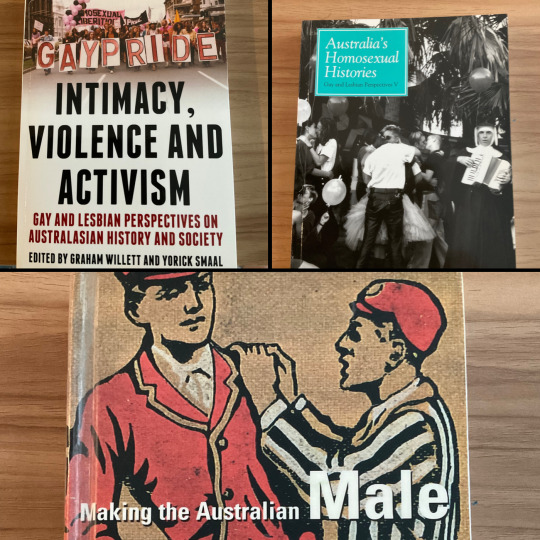
My upcoming thesis readings: Intimacy, Violence and Activism: Gay and Lesbian Perspectives on Australasian History and Society eds. Graham Willett and Yorick Smaal; Australia’s Homosexual Histories, Gay and Lesbian Perspectives V eds. David L. Phillips and Graham Willett; Making the Australian Male: Middle-Class Masculinity 1870-1920 by Martin Crotty.
As with a lot of works on histories of sexuality and gender dating from the early 2000s to the 2010s, these works reflect both the more expansive use of the term ‘homosexual’ (in which trans subjects are encompassed by the term, albeit through dubious assumptions about the relationship between trans people and sexuality) and the relative absence of trans historians in academia*, leading to some spectacularly unnuanced approaches to reading historical gender(s).
*In the Australian context, this has been a complete absence until extremely recently.
#history#histblr#historyblr#queer history#lgbtq history#trans history#thesis#history of sexuality#history of gender#australian history
2 notes
·
View notes
Text
I think the most obvious difference— and one that, thankfully, is beginning to be subjected to greater scrutiny— is that it reifies the traditional mind/body divide. The one-sex model, for all its flaws and errors, ultimately grasps the notion of the individual as a product of integrated systems and processes, allowing either one’s sexed traits to influence one’s selfhood, or one’s selfhood to influence one’s sexed traits. Of course, the lack of separation between body and mind— i.e. the need to view body and mind as an integrated whole— is not only (unsurprisingly) more accurate than the binary distinctions favoured in the nineteenth century, but generally supports a more sensible understanding of gender diversity (amongst everyone, not just trans folks). In other words, the idea of a ‘settled’ science that confirms a sharp distinction between sex and gender simply does not exist.
What’s important to note in terms of rhetoric, discourse and theory— and which Laqueur stops short of, because of his periodisation— is that the concept of a separation between sex and gender- in the contemporary sense- derives from medical professionals working after Freud: John Money, Madison Bentley and Robert Stoller (an older but quite accessible text on this is How Sex Changed, by Joanne Meyerowitz, but also Jules-Gill Paterson does current work and writing around this period). Their theories were then taken up and co-opted outside of their original (if debatable) scientific context, filtering into both feminism(s) and academic fields (gender studies, women’s studies, queer studies etc). So arguably, most people discoursing about gender now are merely working with not only received knowledge, but something that’s emerged like the end of a game of telephone: sex is biological fact, gender is identity (i.e. mental and/or emotional) isn’t exactly what was said in the beginning, but it’s what we wound up repeating at the end.
So while the sex/gender split echoes the binary divisions common in English, I think it’s less a product of linguistics and more the use and abuse of theory. As Paterson notes in her post:
“Actually, the word “gender” didn’t mean at all what it does today until the 1950s. Before then, the word “sex” had to do all the heavy lifting. But in that decade a cohort of psychologists, endocrinologists, and plastic surgeons who had been forcing horrifying experiments on intersex infants and children for decades needed a new theory of human development and identity to save the binary.
…
The new word gender, by which these researchers meant our deeply felt sense of being a boy and/or a girl, was supposed to fix that conceptual weakness, to give the binary new teeth. And it did, with a kind of sleight of hand that we are still trying to outsmart all these years later. John Money, a psychologist at the Johns Hopkins Hospital in Baltimore, knew that finding a biological basis for sex could never be the justification for enforcing a match between anatomy and identity. Instead, he changed the terms of engagement. From now on, the issue was not if humans were biologically binary, but rather “the life adjustments of patients in our series”—how normal they felt, or how well they adapted socially. With that twist, a gender identity that did not conform to a binary body could be subject to medical control because it might lead to social stigma, not because there is anything unnatural or unhealthy about it.
Of course, however, ‘gender’ as a concept was then picked up and utilised by ‘cis people’ even more broadly (Paterson problematises the term in her article) for analyses that were not only un/non-scientific, but which bolstered the absolutist notion of a sex/gender dichotomy throughout numerous fields and ideological approaches across the political and philosophical spectrum. In other words: like the one-sex and two-sex models, the sex/gender dichotomy is simply the most recent (pseudo-scientific/theoretical) construction that we’ve come up with and, in reality, is less than a century old.
(Note: Meyerowitz and Paterson work in the context of US trans history, so while the discourses they reference are essential to how sex/gender are understood in the Anglosphere, their broader observations about historical patterns and experiences of trans people are not always relevant outside the US context, or are currently under/not researched).
Reading Thomas Laqueur's Making Sex is fascinating for a number of reasons but it has put at the forefront of my mind more than ever how much this quirk of English of having the sex/gender distinction affects rhetoric, both because some people find it a useful construct for talking about trans people and here in Laqueur where he's looking at the historical conceptualisation of biological sex as both distinct from and interrelated with social gender, because like obviously there is a distinction between biology and social role, but in what ways does this quirk of English shape that understanding?
Most languages would use an adjective to modify the same word, the same essential thing, but English gives them different nouns and thereby, perhaps, suggests a different essence?
23 notes
·
View notes
Text

(Photo: the Ross Female Factory, Tasmania)
After around a year of silence, I’m rebooting this old tumblr with an About/intro.
I’m Jack, a history student (currently doing Honours) + volunteer at the Australian Queer Archives.
My blog focuses on history, especially histories of sexuality, gender, carcerality & colonialism (and their intersections). My own specialisations are in the history of sexuality & gender in colonial Australia, with a particular emphasis on the nineteenth century in the colony of Victoria. My thesis is tentatively titled “The Presence Of Such Monsters”: Victorian Sodomy Trials 1850-1870, and the Establishment of Sexual Hegemony. It explores the role of the moralising narratives constructed around sodomy trials in establishing the dominance of the white, bourgeois settler-colonial family necessary to the colonial project.
I also post about studying more generally, or things I find while archiving.
3 notes
·
View notes
Text



(Top to bottom: Cindy Patton, Resistance and the Erotic: Reclaiming History, Setting Strategy as we Face AIDS; Walta Borwaski, Poem; Michael Bronski, Death and the Erotic Imagination.)
One of the pleasures of volunteering with the Australian Queer Archives is getting the time to explore the periodicals that come through. These particular images are from Radical America (digitised here), and reflect the overtly left-wing political organising of parts of the gay community in the 1980s. The magazine itself covers a broad range of topics, often written from within impacted communities, from Black Liberation to the British miner’s strike.
10 notes
·
View notes
Text
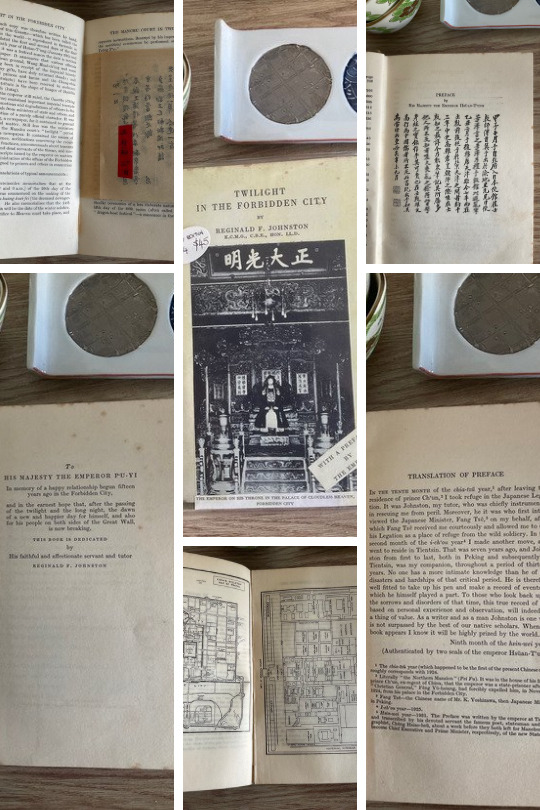
This week’s find at the Saturday book markets was a first edition of Twilight in the Forbidden City by Reginald F. Johnston, published in 1934. Johnston served as the tutor of Puyi (溥儀), the last emperor of China, and his testimony to the events of the period should certainly not be taken at face value- though their content later impacted Puyi’s testimony at the International Military Tribunal for the Far East in 1946. Taken as a source, however, it’s a fascinating find. The book itself is a treasure: the maps of the Forbidden Palace fold out, and a number of the Chinese documents (see the top left corner) are reproduced untranslated and as written at the time, on incredibly fragile paper. Johnston specifically notes at times that they are reproduced in full for ‘possible readers of Chinese nationality’ as well as fluent readers outside of the country.
2 notes
·
View notes
